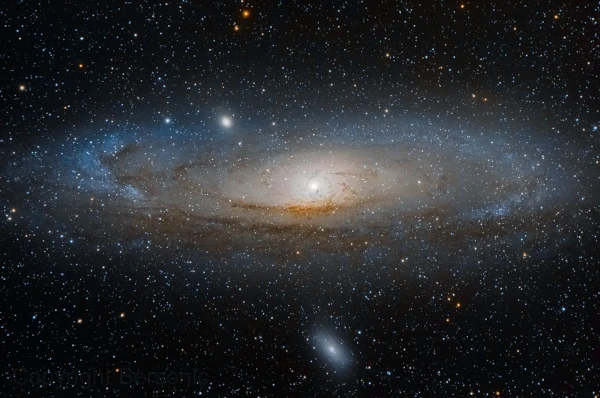
Image Description: The Andromeda Galaxy is the closest galaxy to our own Milky Way galaxy. Our galaxy is very similar to Andromeda. Andromeda's diffuse light is caused by the hundreds of billions of stars that make up the galaxy. The many distinct stars surrounding the image of Andromeda are actually stars in our galaxy, well ahead of Andromeda, which is about two million light-years away. Source NASA.
The history of astronomy in the early 20th century is marked by the figure of Vesto Melvin Slipher (1875-1969), an American astronomer who played a crucial role in our understanding of nebulae and the movement of galaxies. Slipher conducted a series of fundamental observations on the spectral shift of light emitted by these celestial objects, a discovery that would lead to one of the most important theories in modern cosmology: the Expansion of the Universe.
In the early 20th century, nebulae (what we now call galaxies) were still poorly understood. The exact nature of these distant objects remained unclear, and some astronomers believed they were clouds of gas within our own galaxy. Others, however, suspected they were in fact "
In 1912, while working at the Lowell Observatory in Arizona, Vesto Slipher began examining the light spectrum of spiral nebulae. Using spectroscopic techniques, Slipher studied the light emitted by these nebulae. He expected to deduce the chemical composition of the objects and their radial velocity, that is, their speed of movement relative to the Earth.
The central phenomenon behind Slipher's discoveries is the Doppler effect, a well-known concept in wave physics. This effect describes how the frequency of a wave changes based on the relative motion of the source to an observer.
By studying the spectra of nebulae, Slipher discovered that many of them exhibited a red shift. This meant that these objects were moving away from the Earth. Even more surprisingly, these speeds were incredibly high, measuring that some nebulae were moving at over 1000 km/s.
Slipher's work took on even greater significance after the work of Edwin Hubble (1889-1953). In 1929, Hubble used Slipher's measurements to establish a relationship between the distance of galaxies and their recession velocity, forming the basis of the Hubble's Law. This law states that the farther a galaxy is, the faster it is receding, suggesting that the universe is expanding.
Although Slipher did not himself propose the idea of the expansion of the universe, his work was fundamental to this discovery. His observations of red shifts were the first direct evidence that the universe was dynamic, rather than static.
Slipher's methods relied on the use of a spectroscope, an instrument that separates the light from an object based on its wavelengths. To observe nebulae, Slipher used long exposure times, sometimes several dozen hours, to capture enough light from these distant objects. He then compared the observed spectral lines with those of known elements on Earth to determine the radial velocity based on their Doppler shift.
Slipher was thus able to measure the radial velocities of 21 spiral nebulae before 1925, significantly contributing to the early evidence that nebulae were, in fact, galaxies outside the Milky Way.
The pioneering work of Vesto Slipher on the spectral shift of nebulae provided the first observational proof of the expansion of the universe. His discoveries on the high radial velocities of distant galaxies paved the way for further developments in cosmology, including Hubble's Law.